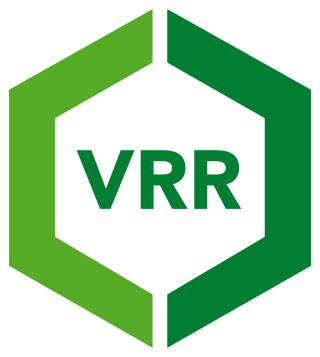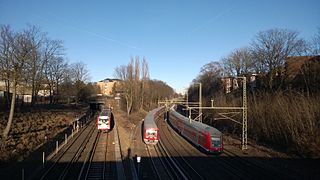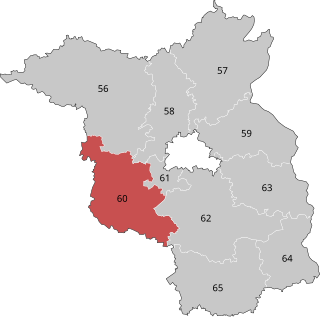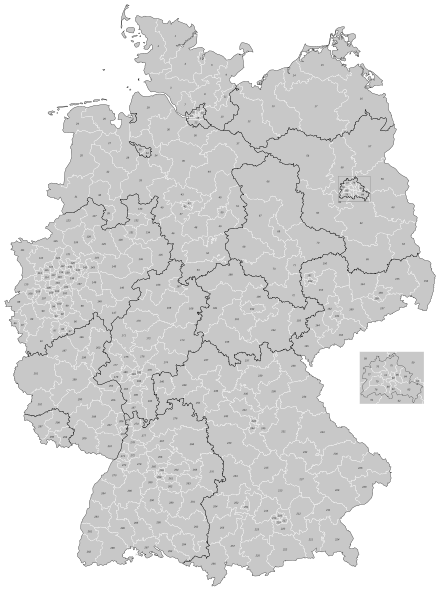Osnabrück is a district (Landkreis) in the southwest of Lower Saxony, Germany. With 2,122 km2 it is the second largest district of Lower Saxony.
Recklinghausen is a Kreis (district) in the centre of North Rhine-Westphalia, Germany. It is surrounded by the neighbouring districts of Borken, Coesfeld, Unna, Gelsenkirchen, Bottrop, and Wesel. The district administration is located in the city of the same name.

In 13 German states, the primary administrative subdivision higher than a Gemeinde (municipality) is the Landkreis or Kreis. Most major cities in Germany are not part of any Kreis, but instead combine the functions of a municipality and a Kreis; such a city is referred to as a kreisfreie Stadt or Stadtkreis.

The Province of Hanover was a province of the Kingdom of Prussia and the Free State of Prussia from 1868 to 1946.

The Verkehrsverbund Rhein-Ruhr, abbreviated VRR, is a public transport association (Verkehrsverbund) in the German state of North Rhine-Westphalia. It covers most of the Ruhr area, as well as neighbouring parts of the Lower Rhine region, including Düsseldorf and thus large parts of the Rhine-Ruhr conurbation. It was founded on 1 January 1980, and is Europe’s largest body of such kind, covering an area of some 5,000 km2 (1,900 sq mi) with more than 7.8 million inhabitants, spanning as far as Dorsten in the north, Dortmund in the east, Langenfeld in the south, and Mönchengladbach and the Dutch border in the west.
Transdev Germany is the largest private operator of passenger buses and trains in Germany. It is a subsidiary of Transdev.

Teltow [German pronunciation:['tɛltoː] ] is a town in the Potsdam-Mittelmark district, in Brandenburg, Germany.
Call a Bike is a dockless bike hire system run by Deutsche Bahn (DB) in several German cities. Developed in 1998 and in operation since 2000, Call a Bike uses a system of authentication codes to automatically lock and unlock bikes.

Hanseatic flags are the banners of Hanseatic cities that were flown by cogs and other ships of the Hanseatic League from 13th to 17th centuries.

Rapid transit in Germany consists of four U-Bahn systems and 14 S-Bahn systems. The U-Bahn, commonly understood to stand for Untergrundbahn, are conventional rapid transit systems that run mostly underground, while the S-Bahn or Stadtschnellbahn are commuter rail services, that may run underground in the city center and have metro-like characteristics in Munich, Hamburg and Berlin which they only have to a lesser extent in other cities. There are also over a dozen premetro or Stadtbahn systems that are rapid transit in the city center and light rail outside.

Brandenburg an der Havel – Potsdam-Mittelmark I – Havelland III – Teltow-Fläming I is an electoral constituency represented in the Bundestag. It elects one member via first-past-the-post voting. Under the current constituency numbering system, it is designated as constituency 60. It is located in western Brandenburg, comprising the city of Brandenburg an der Havel, most of the Potsdam-Mittelmark district, and parts of the Havelland and Teltow-Fläming districts.

Ludwigslust-Parchim II – Nordwestmecklenburg II – Landkreis Rostock I is an electoral constituency represented in the Bundestag. It elects one member via first-past-the-post voting. Under the current constituency numbering system, it is designated as constituency 13. It is located in western Mecklenburg-Vorpommern, comprising the eastern parts of the districts of Ludwigslust-Parchim and Nordwestmecklenburg, and the northwestern part of Landkreis Rostock.

Ort der Vielfalt is an initiative launched in 2007 by the Federal Ministry of Family Affairs, Senior Citizens, Women and Youth, the Federal Ministry of the Interior and the Federal Government Commissioner for Migration, Refugees and Integration with the aim of strengthening the commitment of communities, towns and districts in Germany to cultural diversity. This initiative comes from the federal programmes Vielfalt tut gut. Jugend für Vielfalt, Toleranz und Demokratie and kompetent. für Demokratie – Beratungsnetzwerke gegen Rechtsextremismus. Since 1 January 2011, the Federal Programme Toleranz fördern – Kompetenz stärken has again been continuing the two federal programmes under one roof.

Mecklenburgische Seenplatte II – Landkreis Rostock III is an electoral constituency represented in the Bundestag. It elects one member via first-past-the-post voting. Under the current constituency numbering system, it is designated as constituency 17. It is located in central Mecklenburg-Vorpommern, comprising the most of the Mecklenburgische Seenplatte district and the southern part of the Landkreis Rostock district.











